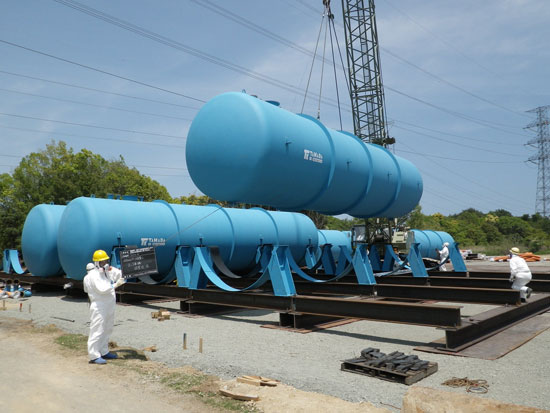Japan has just developed a new radioactive material
National Institute of Materials Science (NIMS) Japan has successfully announced the development of a new material capable of removing radioactive iodine and strontium in contaminated water with high efficiency.
>>>Japan 'rescues' Russia's radioactive treatment plant

Workers are installing contaminated water tanks at the Fukushima I. plant (Source :: AFP)
The institute will cooperate with the Japan Nuclear Power Research and Development Agency to quickly bring the new material into application in troubleshooting the Fukushima I. nuclear power plant.
This new material in the form of silicon dioxide compound (SiO 2 ) has a multitude of holes with a diameter of 2-20 nanometers (1 nanometer by 1 / billion meters) and the inner wall of the holes is coated with a compound layer. special. This new material can absorb radioactive iodine and strontium by changing the types of compounds.
According to NIMS, 1 gram of new material can smoke 20 milligrams of iodine or 13 milligrams of strontium. If converted to a concentration of strontium 90 in a nuclear reactor, it is equivalent to 65 billion becquerels.
Current radioactive reducing agents often absorb strontium-like iodine salts, magnesium and calcium, so the radioactive reduction efficiency in seawater is very low. The new radioactive reduction material will overcome this situation, but it can be used many times in reducing radioactive iodine.
A scientist in the research team said a few tons of new materials could be produced each day. The laboratory production cost is about 60-70 yen / 1 gram, the cost is low, but the effectiveness of radioactive decontamination is very high.
- New material that cleans radioactive effects of cancer
- Japan planted radiation-resistant sunflowers
- Clean 1 ton of radioactive water with 1 gram of new material
- Radioactive substances from Japan travel around the world
- Nuclear laboratory in Japan leaked radiation
- Application of radioactive substances in Medicine and Biology
- Radioactive leaks in eastern Japan
- Japan's Fukushima plant, which is used to save asphalt
- Radioactive material from the Fukushima disaster is found in California
- A small amount of Japanese radiation flew to the United States, the number of victims exceeded 17,000
- The robot also died at the radioactive area of Fukushima
- Japan published a map of radioactive accumulation
 Is the magnetic North Pole shift dangerous to humanity?
Is the magnetic North Pole shift dangerous to humanity? Washington legalizes the recycling of human bodies into fertilizer
Washington legalizes the recycling of human bodies into fertilizer Lightning stone - the mysterious guest
Lightning stone - the mysterious guest Stunned by the mysterious sunset, strange appearance
Stunned by the mysterious sunset, strange appearance